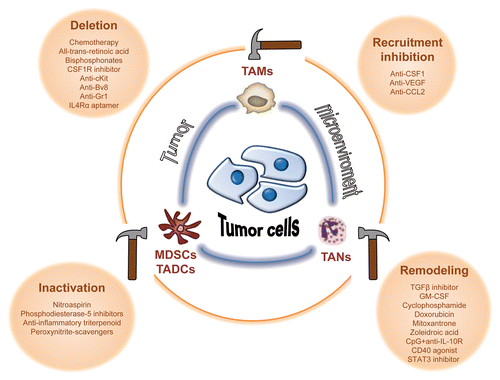Figures & data
Figure 1. Main cancer-promoting functions of tumor-infiltrating immune cells. Tumors are infiltrated by immune cells that support tumor growth by: 1) promoting angiogenesis; 2) driving immunosuppression; and 3) stimulating extracellular matrix remodeling. CCL, (C-C) motif chemokine; DC, dendritic cell; ECM, extracellular matrix; FGF, fibroblast growth factor; IL-10, interleukin-10; MDSC, myeloid-derived suppressor cell; PGE2, prostaglandin E2; TGFβ, transforming growth factor β; VEGF, vascular endothelial growth factor.

Figure 2. Strategies to modulate tumor-associated myeloid cells. The immunosuppressive activity of tumor-associated myeloid cells can be abrogated by immunotherapeutic agents aiming to: 1) deplete these cells; 2) reduce their recruitment to the tumor microenvironment; 3) inactivate their tumor-promoting functions; or 4) remodel tumor-infiltrating myeloid cells to convert suppressive myeloid subtypes to those with antitumor properties. Bv8, prokineticin 2; CCL22, C-C motif chemokine 22; c-Kit, cellular Kit proto-oncogene; CpG, CpG oligodeoxynucleotides; CSF1, colony stimulating factor 1; CSF1R, CSF1 receptor; GR-1, granulocyte-differentiation antigen-1; IL-4Rα, interleukin 4 α-chain receptor; STAT3, signal transducer and activator of transcription 3; TGFβ, transforming growth factor-β; VEGF, vascular endothelial growth factor.

